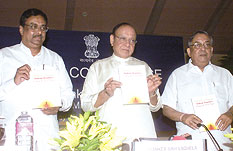In the past 2 years, the Ministry of Textiles under the leadership of Shri Shankersinh Vaghela has taken giant and rapid strides towards becoming a major player in the global textile sector. Every activity is now geared to earn more foreign exchange, create more employment in the Textile sector, and attract greater investment.
For the Ministry of Textiles and its various undertakings, export councils, research associations, boards, committees, the past two years have been about shifting to higher gears and lifting performance. As a result, once perceived as a sunset sector, it has made a dramatic turnaround, and now is very much a part of the sunrise sector, with a very bright future. |

GRAND MOMENT: At a crowded media conference, Minister of Textiles Shankersinh Vaghela (centre) releases a book on Indian textiles. He is flanked by Minister of State E.V.K.S. Elangovan and Secretary Textiles D. P. Singh (right) |
A comprehensive Vision Statement for the Textile Industry prepared by CRISIL on behalf of the Indian Cotton Mills' Federation envisages the growth of the textile economy from the current US$ 37 billion to US $ 85 billion by 2010. This will comprise a domestic market size of US $ 45 billion, and an export market size of US $ 40 billion. Another study made by the Government of India places the export market size at US $ 50 billion in the year 2010.
A huge feather in the cap of the Ministry of Textiles has been the passing of the NIFT Act in Parliament earlier this week. The Act provides statutory status to the prestigious National Institute of Fashion Technology and formally recognizes its leadership in the fashion technology sector. NIFT will now be able to award degrees to students across the country, and its designers will be further motivated to put India firmly on the Fashion Map of the world.
Statistics will tell only a part of the turnaround story, but they are, nevertheless, very vital and important. Here are some of the key turnaround stories:
EXPORTS ON A HIGH
- Total exports in 2005-2006 stood at about US$ 17 billion (Rs. 76,500 crore), up from about US $ 13 billion (Rs 58,584 crore) in 2004-2005. The target for 2010 is US $ 40 billion. The sustained surge in textile exports is continuously increasing the competitiveness of the Textile Sector.
- In 2005, textile exports to the US increased by 26 per cent, while that to the European Union increased by 18 per cent.
HIGHER INVESTMENTS, GREATER SUBSIDIES, MORE JOBS
- In 2005-06, a record Rs 30,032 crore worth of investments flowed into the Textile Sector. In comparison, investments stood at Rs 2,938 crore in 2002-03, Rs 6,589 crore in 2003-04, and Rs 14,850 crore in 2004-05. The investment projection for 2010 is a phenomenal Rs 1,40,000
crore.
- Much of this investment is expected to flow in by way of the very modern and visionary Scheme for Integrated Textile Parks. The SITP was launched in August 2005 and it seeks to build 25 large textile parks of the highest international standards by 2007. It seeks to facilitate investment flow of Rs 18,500 crore, create 5 lakh jobs. Thus far, 9 parks have been sanctioned by the Ministry of Textiles.
- Already, in a short span of 24 months, the Textile Sector has created about 20 lakh jobs. By 2010, another 120 lakh jobs will be created.
- To facilitate growth and expansion in the Textile Sector, the Ministry has further increased subsidy of the highly innovative Technology Upgradation Fund Scheme (TUFS). For 2006-07, subsidy was enhanced to Rs 535 crore from Rs 435 crore in 2005-06.
- Under TUFS, a record 2,064 proposals involving Rs 22,381 crore were processed and sanctioned by the Ministry of Textiles in the last two years. In comparison, the TUFS attracted investments to the tune of only Rs 1,787 crore in 2002-2004 period.
TECHNOLOGY MISSIONS, NATIONAL POLICIES
- Following the announcement of the National Jute Policy in 2005, a Jute Board is being constituted. It is overseeing the merger of the National Centre for Jute Diversification and the Jute Manufacturers Development Council with a view to improving productivity. The National Common Minimum Programme (NCMP) attaches a great deal of importance to the jute sector, India is the world's largest jute producer, and the second largest exporter of jute goods. Besides, a Technology Mission on Jute is set to be launched next year at a cost of Rs 2,000
crore.
- Likewise, a Technology Mission on Silk will be launched at a cost of Rs 2,000 crore and a Technology Mission on Wool will be launched at a cost of Rs 90
crore.
HANDICRAFTS AND HANDLOOMS
- To benefit India's handloom sector, the Mahatma Gandhi Bunkar Bima Yojna covering 2.41 lakh weavers and the Health Insurance Scheme benefiting 2.05 lac weavers were launched. Besides, 20 handloom clusters were developed all over the country at a cost of Rs 50
crore.
- 37 Urban Haats on the pattern of Dilli Haat were established to provide marketing platforms to artisans. In addition, 6 Gandhi Shilp Haat Schemes were launched.
MILL MODERNISATION
- A Group of Ministers has been set up to take quick decisions on turning around the mills. Today, the N.T.C. is left with 52 viable mills. 22 mills have been identified for modernization. It is proposed that 29 mills be revived through joint ventures. An India International Trade Tower (IITT) is proposed to be constructed on a mill land in
Mumbai.
- The net worth of the N.T.C. is projected to become positive in 2006-07, a significant achievement of the U.P.A. Government and the Ministry of Textiles. The total cost of the rehabilitation scheme is Rs 5,267.56 crore, the waiver of interest will be to the tune of Rs 2,166.87 crore.
|